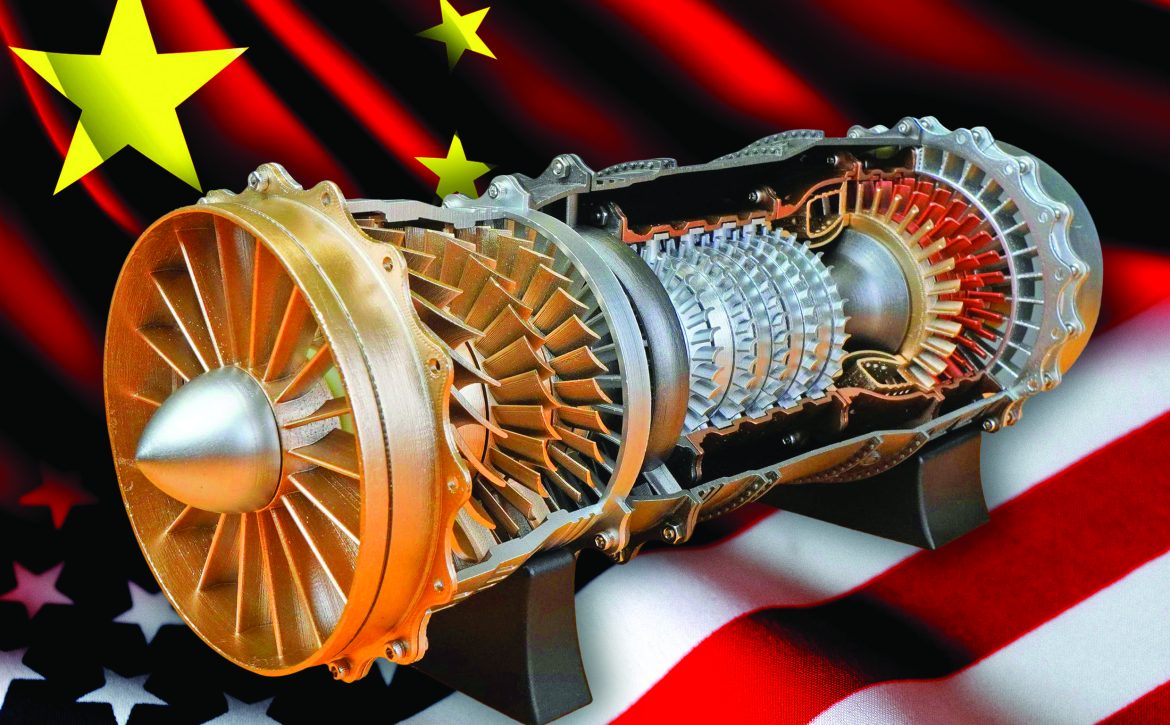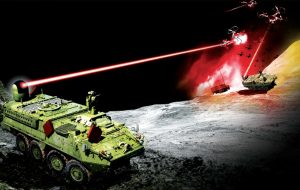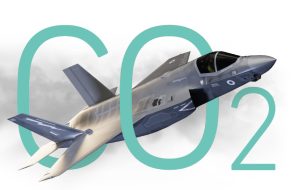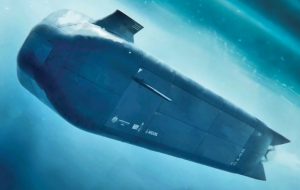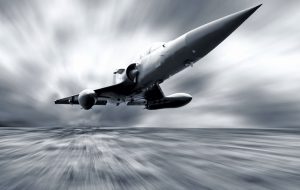China’s fighter jet engine technology took a major leap forward on 29th June 2023, when the first flight test was conducted on a new variant of the J-20 stealth fighter, with a serial number 2052, powered by two WS-15 turbofan engines. This long-awaited engine project has sparked intense interest within and outside China since the early 2000s, thus this milestone prompts questions about the future of US dominance in fighter jet engine tech.
WS-15 Development Background
In late June, Chengdu Aircraft Corporation (CAC) conducted the maiden flight of the new variant J-20 fighter, fitted with two WS-15 turbofan engines, also known as “Emei”. China embarked on developing this engine in the mid-2000s, originally under the J-XX program.
A preliminary image of the WS-15 engine emerged in 2006, five years before the J-20 prototype was unveiled. However, supplied components were only used for individual testing initially.
The full-scale demonstration project was not completed until 2012 and extensive trials followed over subsequent years. In July 2018, the Chinese academic overseeing aviation engine R&D in Beijing, Liu Daxiang, announced that WS-15 development was progressing rapidly and would be fully completed within three years.
The J-20 was intended to operate on WS-15 engines but China’s fighter jet engine industry was still nascent. This compelled China to use an interim engine to power its new stealth fighter until the primary engine was ready.
Initially, the Russian AL-31 powered the J-20. This was replaced by the domestic WS-10C engine in 2019, which China started developing in the early 2000s for the J-11 fighter. While reducing imports, the WS-10C lacked stealth, supercruise and thrust vectoring capabilities, making it an unsuitable long-term solution.
Estimates vary on when WS-15 development actually began. Some point to the 1990s, while others believe the real start was in 2006, arguing that the 1990s saw only preliminary steps before full-scale development. In any case, the long timeframe allowed repeated design enhancements before reaching the current version.
While the full capabilities of the WS-15 engine remain shrouded in some secrecy, Western reports have revealed glimpses of its initial features.
The Chinese engine promises higher thrust than the interim powerplants previously used for the J-20 fighter. It should also provide greater kinematic performance and supersonic speed for the aircraft, increasing the platform’s air superiority potential.
Moreover, the WS-15 features “supercruise” technology. This makes it only the second fighter after the American F-22 with this capability. Supercruise enables supersonic flight without the need for fuel-guzzling afterburners.
The WS-15 thrust reportedly reaches around 180 kN, surpassing even the F-22’s engine. Although lower than the F-35’s F135 engine, the J-20’s twin WS-15s can jointly generate 360 kN thrust, furthermore, the WS-15 thrust-to-weight ratio is approximately 9.7-11.
Many Western analyses predict the WS-15 will substantially boost the J-20’s performance and combat effectiveness. It will likely achieve 2.8 Mach speed, fire Thunderbolt missiles, and increase low-altitude manoeuvrability and supercruise potential. This enhances the J-20’s air superiority and combat capabilities.
The WS-15 relies on an after-burning turbofan configuration with advanced design features. These help provide high thrust and improved fuel efficiency, causing many analysts to compare the engine to the F135 powering America’s F-35 fighter.
Furthermore, the WS-15 can boost kinematic performance and thermal management traits, enabling consistent supercruise abilities and supporting electrical power generation, thus the engine offers increased growth and sustainment potential over the long term.
The initial J-20 prototype powered by the WS-15, is an upgraded J-20 variant. It contains extensive subsystem upgrades and external modifications. The WS-15 will likely see further enhancements.
Moreover, It is expected to spawn new variants that will power China’s sixth-generation fighter program.
The latest variant of the J-20 stealth fighter with the WS-15 has some external design features. It sports a distinctively long dorsal spine behind the cockpit for aerodynamic benefits.
The nose dome shape is slightly altered along with small inlet adjustments. However, major enhancements on this J-20 variant appear invisible externally. They include extensive avionics, flight systems, and growth capability upgrades. Some assessments suggest the extent of improvements added could make this variant rival a 5.5-generation fighter. Others consider it an interim 5th-6th generation platform.
Moreover, the Chinese military hasn’t settled on a name for the different variants of the J-20 fighter yet. Some call the new WS-15-equipped generation the J-20B, while the previous single-seat variant, powered by an AL-31/WS-10C engine is called the J-20A.
However, sometimes J-20A refers to the newer WS-15-powered jet instead. Here, the current single-seat, AL-31/WS-10C jet is simply called J-20. As upgrades continue, the J-20 variant terminology remains fluid.
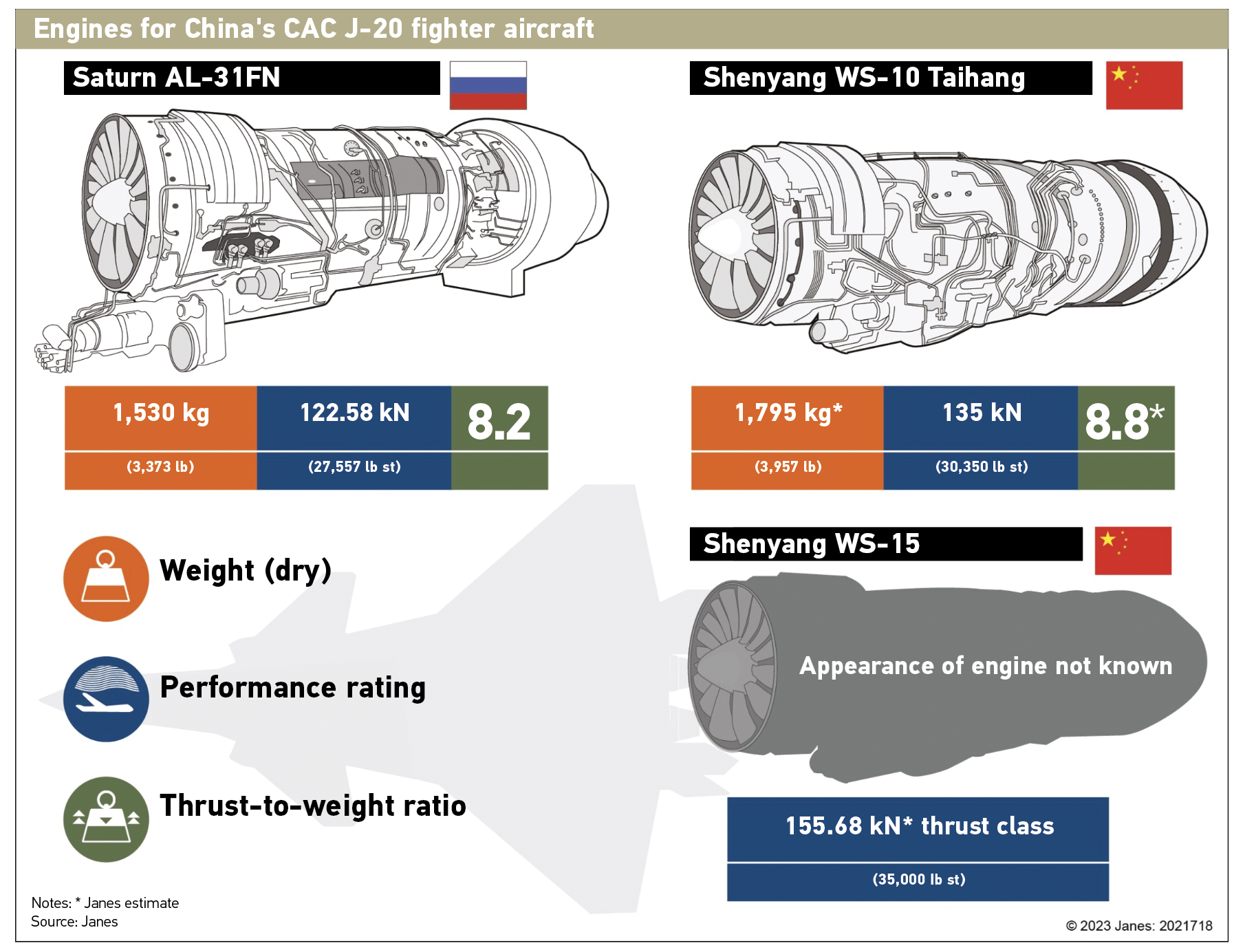
China’s Future Fighter Fleet
The maiden flight images of China’s J-20 stealth fighter with the new engine generated enormous Western interest. Despite representing a major accomplishment for China’s thriving aviation industry, neither the US nor its allies expressed any alarm over the J-20 itself as a 5th-gen stealth fighter. However, Washington appears extremely concerned by the pace of China’s fighter jet engine progress.
In March 2023, WS-15 project chief Chang Young at the AECC Beijing Institute of Aeronautical Materials announced at the 7th Chinese Aviation Innovation and Entrepreneurship Competition (CAIEC) that engine production bottlenecks were resolved thanks to domestic advances in metallurgy and manufacturing.
This enabled supplying high-temperature components like single-crystal turbine blades, superalloy disks and rings, and mounting systems for advanced propulsion, thus the WS-15 is now ready for mass production.
This will boost Chinese fighter capabilities, especially the 5th-gen J-20. Simplified supply chains allow AECC to manufacture many engine components domestically.
Estimates of the J-20 fleet size have attracted intense Western interest. Per the Zhuhai Airshow 2022 , some estimates indicate the fleet exceeded 208 airframes by November 2022. Others show between 170-180 airframes by the end of 2022.
By June 2023, more estimates revealed China’s J-20 production surpassed the US F-22’s total production of around 187 jets – years ahead of earlier forecasts.
This highlights China’s accelerating production pace. Reports suggest China’s annual J-20 production nears 100 jets. Over 70 were already delivered to the military by July. China’s total J-20 fleet likely reached 200-250 fighters so far and is expanding steadily.
Challenging US Engine Dominance
Historically, China relied on the Soviet Union, and later Russia, for fighter jet engines but also pursued indigenous production since the 1970s, partnering with Russian and Western companies for spare parts, assembly lines and know-how.
This allowed for the gradual acquisition of technical knowledge and tools to incrementally develop domestic engines, however eventually, reverse-engineering Russian Su-27 technologies enabled China’s first locally built engine.
China’s first fully domestically designed, manufactured and tested turbofan engine emerged at the Zhuhai Airshow 2022 – the WP-14, which took 20 years to develop. It powered later variants of China’s older Russian-derived fighters.
Despite not being cutting-edge, the WP-14 marked a major milestone for China’s jet engine industry, providing the foundation for the WS-10 engine, a key step in boosting China’s fighter jet engine capabilities and reducing foreign reliance.
Nonetheless, China concluded it urgently needed to address shortcomings in designing reliable, effective fighter jet engines and excessive foreign dependence.
Hence, in August 2016, China consolidated various engine production units under the state-owned Aviation Industry Corporation of China (AVIC) into a new independent entity – the Aero Engine Corporation of China (AECC), valued then at $7.5 billion.
AECC is a prominent Chinese turbofan developer established alongside major investments to advance China’s fighter jet engine program. By 2018, AECC unveiled five different engines at the Zhuhai Airshow, most notably the WS-10 Taihang, heralding a new generation of turbofan engines spearheaded by the WS-15.
A report by the US Center for Strategic and International Studies noted China’s investments are poised to threaten US dominance in fighter jet engine technology in coming years.
China is taking a whole-of-government approach to rapidly narrow the traditional gap with the US.
Although the American model has proven responsive to innovation, enabling successive generations of US fighters to maintain qualitative superiority through engine advancements, China’s concerted efforts have led many US assessments to urge policymakers to take more decisive action to sustain the capabilities gap and reconsider the past decade’s low-risk, low-R&D investment approach.
Unlike the Cold War, the US now faces a rival with an equivalent – even superior in some domains – industrial base. Hence, even strategic surprises cannot be ruled out despite current US engine supremacy.
In summary, developing the WS-15 engine underscores the extent of China’s overall and turbofan-specific aviation industry progress. It aligns with some Western estimates that China is moving swiftly towards the cutting edge of fighter jet engine technology.
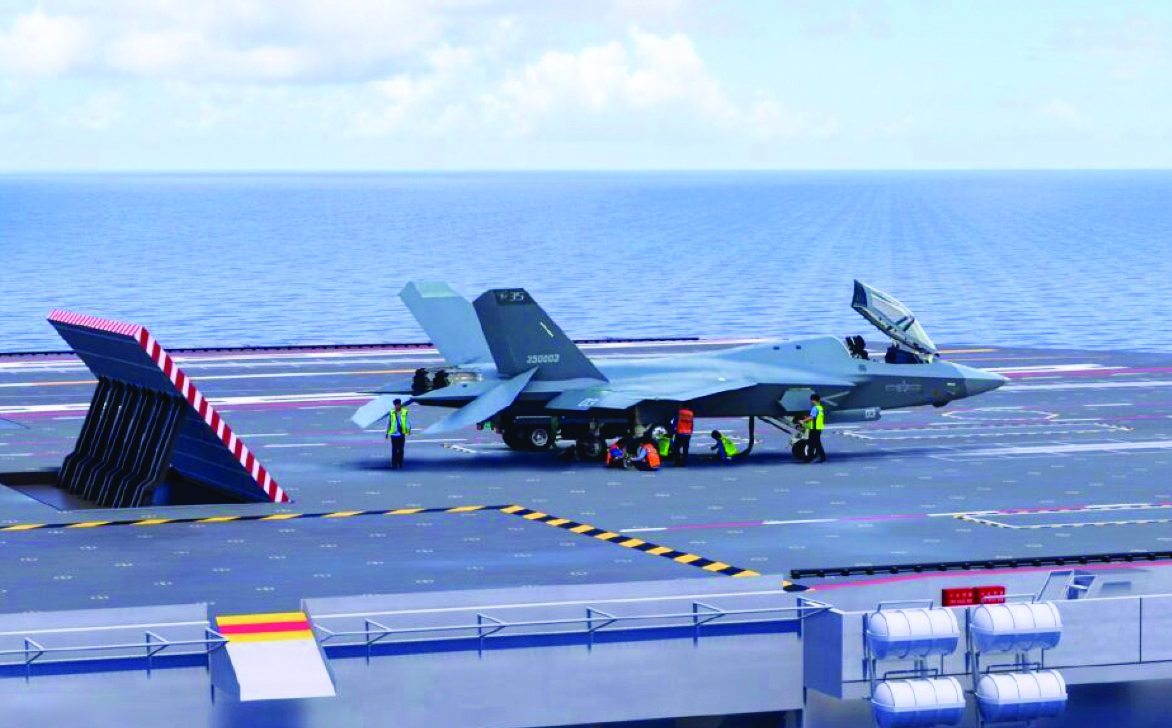
Game Changer
Mastering fighter jet engines is a major technical achievement within reach of only a few nations. China has emerged as a formidable new contender, spending billions in recent years to rapidly build capabilities, leveraging the global spread of technology.
Many anticipate the WS-15 will propel Chinese aerospace to new heights. The J-20 is expected to generally outperform the American F-35. The new engine will enable China to catch up with the US and Russia – the traditional leaders in combat engine technology.
As J-20 production scales up, China will likely accelerate the development of next-gen fighters.
Moreover, given that the Chinese aerospace industry embraces a “national teamwork, comprehensive advancement” philosophy of gradually substituting imported components with localized versions to increase self-reliance. With continuous technological improvements, China’s aerospace industry is poised to assume a leading position in the coming years, especially regarding 6th-gen fighter development.
For instance, AECC is developing new propulsion systems like the WS-19 and WS-20 engines. The WS-19 turbofan is meant for the next-gen carrier-based J-35 fighter. The WS-20 is a high-bypass turbofan expected to power the Chinese Air Force’s Y-20 transports.
Additionally, greater range was previously the Su-35’s sole major advantage over the J-20, with the latter superior in radar, electronics, avionics and other capabilities. The J-20 stealth fighter equipped with the WS-15 turbofan could thus prove transformative, not just vis-à-vis Russian jets but also American and advanced Singaporean fighters.
Deploying the WS-15-powered J-20 over the contested South China Sea can potentially establish Chinese air superiority in any conflict with the US.
Despite lingering challenges, especially US restrictions on certain advanced technologies required by China, American reports caution that further advances in fighter jet engine tech will not only increase China’s military power but also make it a powerful competitor in the global engine market, especially given its willingness to sell products cheaply.
These reports also allude to growing prospects of Russia supplying key technologies to China, which could pave the way for ending the qualitative edge long enjoyed by the US and its allies.
In conclusion, a decade after the J-20’s first flight, it has matured with full operational capability and continues acquiring more capabilities and technological progress through incremental upgrades.
Chief among them is the integration of the WS-15 engine, boosting the stealth fighter’s capabilities and production sustainability while narrowing the gap with the US on fighter jet engine technology.
» By: Adnan Moussa (Assistant Lecturer at the Faculty of Economics and Political Science, Cairo University)


